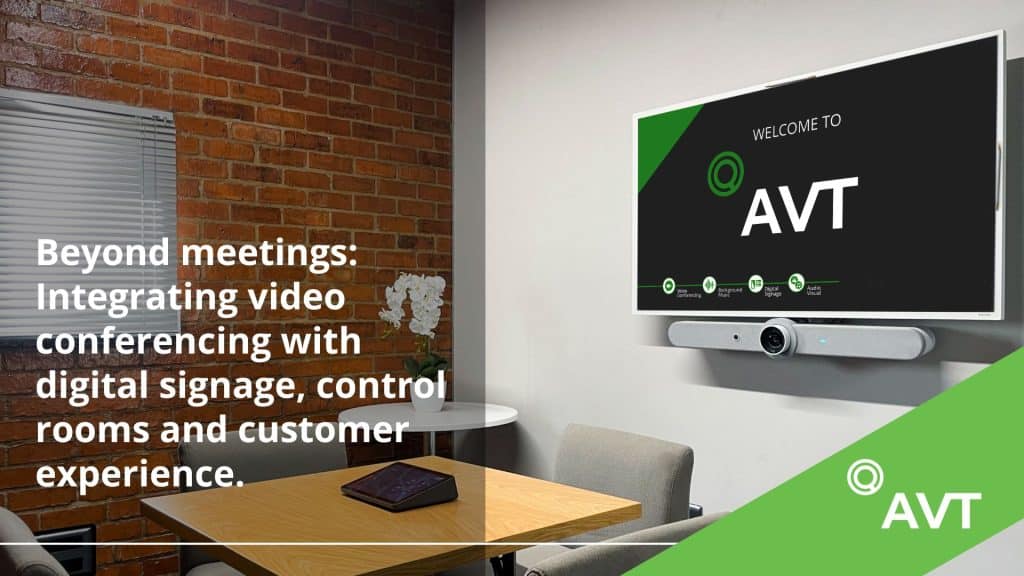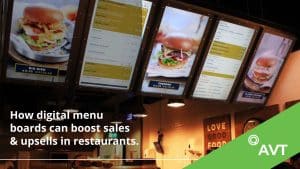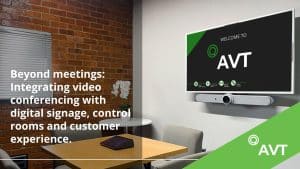Many organisations reach a point where their communication systems no longer keep up with their operational needs. Leadership teams struggle to address staff in multiple regions at once. Branches operate in silos. Control rooms receive fragmented information. Digital signage networks show outdated content because no one manages them centrally. The result is a slow flow of information across a business that needs speed, clarity and consistency.
Integrated video conferencing solves these challenges when it is deployed as part of a wider visual communication environment. At AVT we help organisations link meeting rooms, signage networks, control rooms and customer-facing spaces into a single ecosystem. This approach gives teams real visibility, improves internal coordination and supports sites spread across South Africa and the broader Sub-Saharan region.
The Shift Toward Connected Visual Communication
Most companies start with video conferencing in their boardrooms. Over time they realise the same real time communication tools can support other areas of the business. Digital signage can display live broadcasts. Control rooms can pull in feeds from remote sites. Customer environments can offer remote expert consultations. The value increases when these systems are designed to work together.
We see this shift across corporate campuses, financial institutions, manufacturing, utilities, logistics and retail. These organisations want consistency across their facilities and a reliable way to share information between staff, customers and operations. Our role at AVT is to help them integrate these platforms and manage them as they scale.
Extending Video Conferencing Beyond Meeting Rooms
Corporate and multi building environments
Large campuses often have several buildings with different room types. They need a similar experience for staff moving between spaces. When we deploy video conferencing across a campus, we link meeting rooms, training venues, reception areas and signage networks so everything runs from a central platform. Leadership teams can speak to staff across the site at short notice, and messages reach everyone at the same time.
Regional and multi country rollouts
Companies with branches in Johannesburg, Cape Town, Durban, Namibia, Botswana, Zambia or Kenya face a different challenge. Teams operate far from head office and need a reliable way to stay connected. We build environments where video conferencing, digital signage and control systems share the same core infrastructure. This allows head office to push updates to all regions, run live broadcasts and support remote sites with technical visibility.
Digital Signage Supported by Live Video
Digital signage is becoming a critical part of internal and customer communication. When it supports live video, it becomes even more powerful.
Blending scheduled content with real time updates
A signage display screen can switch from scheduled content to a live broadcast from a video conferencing platform. Executives can talk directly to staff across all branches. Safety officers can issue urgent notifications. Facilities teams can push campus wide announcements. At AVT, we design digital signage systems that integrate with the same hardware and platforms used for meetings, which keeps management simple and keeps content accurate.
Customer experience applications
Many sectors benefit from adding live video into customer spaces.
-Retail stores can connect shoppers to remote product experts.
– Hospitality and healthcare facilities can offer virtual concierge or patient assistance.
-Automotive and property showrooms can run live walk throughs from off-site locations.
These environments rely on stable video routing, signage players and controlled switching. Our team installs and maintains these systems so customer facing teams never lose connection when they need it.
Linking Video Conferencing to Control Rooms
Control rooms, NOCs and SOCs require constant visibility of operations. They depend on accurate inputs from remote sites, teams and devices. When video conferencing integrates with these environments, operators can escalate issues faster and collaborate with field personnel in real time.
Situational awareness
A control room can receive live video from a remote facility, plant, vehicle yard or data center. Operators can request a video call from an on-site technician when they need confirmation during an incident. When these video sources connect into large format displays, operators gain a clear view that supports quicker decisions.
Interoperability and unified environments
Most control rooms rely on several platforms. Many still use SIP and H.323 endpoints alongside cloud platforms such as Microsoft Teams, Webex or Zoom. AVT integrates these systems so they can communicate without friction. This removes the need for separate workflows and gives operators a central place to manage calls, feeds and layouts.
Infrastructure Required For a Connected Ecosystem
These environments rely on more than cameras and displays. They depend on solid infrastructure.
Network readiness
Video traffic places a clear demand on networks. Bandwidth planning, QoS policies and SD WAN or MPLS design all play a part in call quality. Latency, jitter and packet loss must be managed to keep real time video stable. When we design environments for clients, we assess the network and guide IT teams on the changes needed to support the system.
Hardware and room design
Integrated visual communication requires hardware that can scale. This includes room systems, PTZ cameras, video bars, DSPs, LED walls, signage players and control processors. Our design engineers select equipment that fits both the technical requirements and the room architecture. We also ensure the system can grow when the organisation expands to new sites.
Security and compliance
South African organisations have strict obligations under POPIA. Secure content distribution, encrypted calls and role based access are essential. Control rooms often handle sensitive information, so we help clients enforce access rules that keep sources restricted to authorised staff.
Why Organisations Trust AVT
We understand how to design and integrate video conferencing, signage, control rooms and unified communication platforms into a single architecture. Our experience across South Africa and the greater Sub-Saharan region gives us insight into the realities of regional networks, diverse facilities and distributed teams. We focus on reliability, support and long-term performance because these systems play a critical role in daily operations.
Closing thoughts
Video conferencing is no longer limited to meeting rooms. When it integrates with signage networks, control rooms and customer environments, it becomes a central part of how an organisation communicates. At AVT we help businesses create connected systems that support staff, operations and customers at every level. If your organisation wants a unified approach to visual communication across all sites, we can guide you through the full process.
Many organisations reach a point where their communication systems no longer keep up with their operational needs. Leadership teams struggle to address staff in multiple regions at once. Branches operate in silos. Control rooms receive fragmented information. Digital signage networks show outdated content because no one manages them centrally. The result is a slow flow of information across a business that needs speed, clarity and consistency.
Integrated video conferencing solves these challenges when it is deployed as part of a wider visual communication environment. At AVT we help organisations link meeting rooms, signage networks, control rooms and customer-facing spaces into a single ecosystem. This approach gives teams real visibility, improves internal coordination and supports sites spread across South Africa and the broader Sub-Saharan region.
The Shift Toward Connected Visual Communication
Most companies start with video conferencing in their boardrooms. Over time they realise the same real time communication tools can support other areas of the business. Digital signage can display live broadcasts. Control rooms can pull in feeds from remote sites. Customer environments can offer remote expert consultations. The value increases when these systems are designed to work together.
We see this shift across corporate campuses, financial institutions, manufacturing, utilities, logistics and retail. These organisations want consistency across their facilities and a reliable way to share information between staff, customers and operations. Our role at AVT is to help them integrate these platforms and manage them as they scale.
Extending Video Conferencing Beyond Meeting Rooms
Corporate and multi building environments
Large campuses often have several buildings with different room types. They need a similar experience for staff moving between spaces. When we deploy video conferencing across a campus, we link meeting rooms, training venues, reception areas and signage networks so everything runs from a central platform. Leadership teams can speak to staff across the site at short notice, and messages reach everyone at the same time.
Regional and multi country rollouts
Companies with branches in Johannesburg, Cape Town, Durban, Namibia, Botswana, Zambia or Kenya face a different challenge. Teams operate far from head office and need a reliable way to stay connected. We build environments where video conferencing, digital signage and control systems share the same core infrastructure. This allows head office to push updates to all regions, run live broadcasts and support remote sites with technical visibility.
Digital Signage Supported by Live Video
Digital signage is becoming a critical part of internal and customer communication. When it supports live video, it becomes even more powerful.
Blending scheduled content with real time updates
A signage display screen can switch from scheduled content to a live broadcast from a video conferencing platform. Executives can talk directly to staff across all branches. Safety officers can issue urgent notifications. Facilities teams can push campus wide announcements. At AVT, we design digital signage systems that integrate with the same hardware and platforms used for meetings, which keeps management simple and keeps content accurate.
Customer experience applications
Many sectors benefit from adding live video into customer spaces.
-Retail stores can connect shoppers to remote product experts.
– Hospitality and healthcare facilities can offer virtual concierge or patient assistance.
-Automotive and property showrooms can run live walk throughs from off-site locations.
These environments rely on stable video routing, signage players and controlled switching. Our team installs and maintains these systems so customer facing teams never lose connection when they need it.
Linking Video Conferencing to Control Rooms
Control rooms, NOCs and SOCs require constant visibility of operations. They depend on accurate inputs from remote sites, teams and devices. When video conferencing integrates with these environments, operators can escalate issues faster and collaborate with field personnel in real time.
Situational awareness
A control room can receive live video from a remote facility, plant, vehicle yard or data center. Operators can request a video call from an on-site technician when they need confirmation during an incident. When these video sources connect into large format displays, operators gain a clear view that supports quicker decisions.
Interoperability and unified environments
Most control rooms rely on several platforms. Many still use SIP and H.323 endpoints alongside cloud platforms such as Microsoft Teams, Webex or Zoom. AVT integrates these systems so they can communicate without friction. This removes the need for separate workflows and gives operators a central place to manage calls, feeds and layouts.
Infrastructure Required For a Connected Ecosystem
These environments rely on more than cameras and displays. They depend on solid infrastructure.
Network readiness
Video traffic places a clear demand on networks. Bandwidth planning, QoS policies and SD WAN or MPLS design all play a part in call quality. Latency, jitter and packet loss must be managed to keep real time video stable. When we design environments for clients, we assess the network and guide IT teams on the changes needed to support the system.
Hardware and room design
Integrated visual communication requires hardware that can scale. This includes room systems, PTZ cameras, video bars, DSPs, LED walls, signage players and control processors. Our design engineers select equipment that fits both the technical requirements and the room architecture. We also ensure the system can grow when the organisation expands to new sites.
Security and compliance
South African organisations have strict obligations under POPIA. Secure content distribution, encrypted calls and role based access are essential. Control rooms often handle sensitive information, so we help clients enforce access rules that keep sources restricted to authorised staff.
Why Organisations Trust AVT
We understand how to design and integrate video conferencing, signage, control rooms and unified communication platforms into a single architecture. Our experience across South Africa and the greater Sub-Saharan region gives us insight into the realities of regional networks, diverse facilities and distributed teams. We focus on reliability, support and long-term performance because these systems play a critical role in daily operations.
Closing thoughts
Video conferencing is no longer limited to meeting rooms. When it integrates with signage networks, control rooms and customer environments, it becomes a central part of how an organisation communicates. At AVT we help businesses create connected systems that support staff, operations and customers at every level. If your organisation wants a unified approach to visual communication across all sites, we can guide you through the full process.
Frequently Asked Questions
How does integrated video conferencing improve communication across multiple branches?
Integrated video conferencing links meeting rooms, signage screens and control rooms across all locations. This gives teams a consistent way to share information, run live broadcasts and escalate issues without relying on separate systems. When everything connects to a single platform, staff in different regions receive updates at the same time. AVT designs these environments so companies can manage communication from one place and reduce delays caused by fragmented tools.
Can digital signage and video conferencing work together in one system?
Yes. Digital signage can display scheduled content, but it becomes far more effective when it receives live video from the company’s conferencing platform. Screens can switch to real time broadcasts, leadership messages, training sessions or urgent updates. This gives organisations a reliable way to deliver information across offices, branches and public areas. AVT builds signage systems that integrate with the same infrastructure used for meetings, which keeps management simple and helps teams maintain accurate, up to date communication.
Why do control rooms benefit from video conferencing integration?
Control rooms rely on accurate, real-time information. When video conferencing integrates with these environments, operators can pull in feeds from remote sites, call technicians in the field and share visuals across large displays. This leads to faster decisions and clearer incident handling. With many control rooms relying on a combination of SIP, H.323 and cloud platforms, AVT ensure everything works together seamlessly, eliminating compatibility issues. The result is a unified environment that gives operators full visibility during critical situations.
What infrastructure is required for a connected visual communication ecosystem?
A stable network, proper QoS settings and adequate bandwidth are essential for real time video. Organisations also need reliable room hardware, signage players, cameras, control processors and displays that can scale across multiple sites. Security is another key factor, especially for POPIA compliance and restricted control room environments. AVT helps clients evaluate their existing infrastructure and implement the upgrades needed to support a connected system. This ensures long term stability and consistent performance across meeting spaces, signage networks and operations centres.
What makes AVT a suitable partner for large regional rollouts?
Companies operating across South Africa and Sub-Saharan Africa need a partner that understands local conditions, regional networks and the complexities of multi-site deployments. AVT has experience designing video conferencing, signage and control room solutions that remain stable across diverse environments. We focus on practical engineering, reliable support and clear communication throughout the rollout. Our teams help organisations standardise their technology across branches, maintain system health through remote monitoring and ensure users receive a consistent experience in every location.





